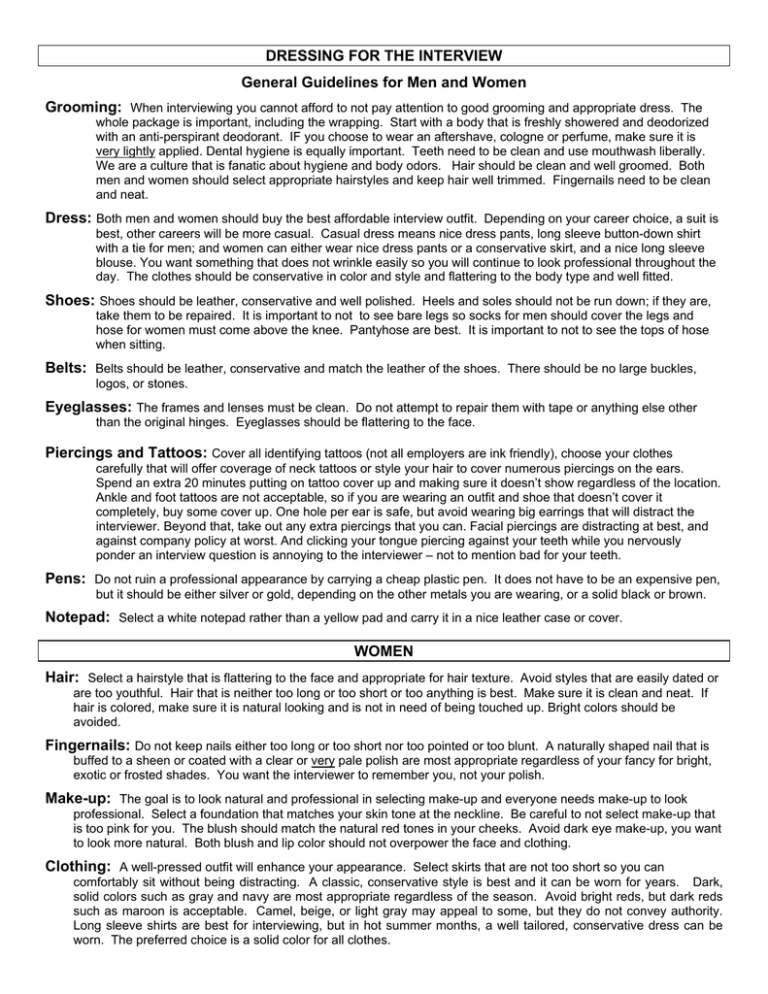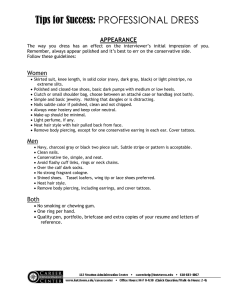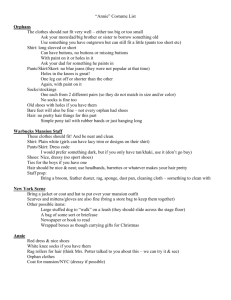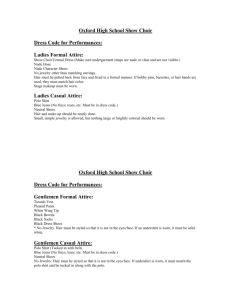DRESSING FOR THE INTERVIEW General Guidelines for Men and Women Grooming:
advertisement

DRESSING FOR THE INTERVIEW General Guidelines for Men and Women Grooming: When interviewing you cannot afford to not pay attention to good grooming and appropriate dress. The whole package is important, including the wrapping. Start with a body that is freshly showered and deodorized with an anti-perspirant deodorant. IF you choose to wear an aftershave, cologne or perfume, make sure it is very lightly applied. Dental hygiene is equally important. Teeth need to be clean and use mouthwash liberally. We are a culture that is fanatic about hygiene and body odors. Hair should be clean and well groomed. Both men and women should select appropriate hairstyles and keep hair well trimmed. Fingernails need to be clean and neat. Dress: Both men and women should buy the best affordable interview outfit. Depending on your career choice, a suit is best, other careers will be more casual. Casual dress means nice dress pants, long sleeve button-down shirt with a tie for men; and women can either wear nice dress pants or a conservative skirt, and a nice long sleeve blouse. You want something that does not wrinkle easily so you will continue to look professional throughout the day. The clothes should be conservative in color and style and flattering to the body type and well fitted. Shoes: Shoes should be leather, conservative and well polished. Heels and soles should not be run down; if they are, take them to be repaired. It is important to not to see bare legs so socks for men should cover the legs and hose for women must come above the knee. Pantyhose are best. It is important to not to see the tops of hose when sitting. Belts: Belts should be leather, conservative and match the leather of the shoes. There should be no large buckles, logos, or stones. Eyeglasses: The frames and lenses must be clean. Do not attempt to repair them with tape or anything else other than the original hinges. Eyeglasses should be flattering to the face. Piercings and Tattoos: Cover all identifying tattoos (not all employers are ink friendly), choose your clothes carefully that will offer coverage of neck tattoos or style your hair to cover numerous piercings on the ears. Spend an extra 20 minutes putting on tattoo cover up and making sure it doesn’t show regardless of the location. Ankle and foot tattoos are not acceptable, so if you are wearing an outfit and shoe that doesn’t cover it completely, buy some cover up. One hole per ear is safe, but avoid wearing big earrings that will distract the interviewer. Beyond that, take out any extra piercings that you can. Facial piercings are distracting at best, and against company policy at worst. And clicking your tongue piercing against your teeth while you nervously ponder an interview question is annoying to the interviewer – not to mention bad for your teeth. Pens: Do not ruin a professional appearance by carrying a cheap plastic pen. It does not have to be an expensive pen, but it should be either silver or gold, depending on the other metals you are wearing, or a solid black or brown. Notepad: Select a white notepad rather than a yellow pad and carry it in a nice leather case or cover. WOMEN Hair: Select a hairstyle that is flattering to the face and appropriate for hair texture. Avoid styles that are easily dated or are too youthful. Hair that is neither too long or too short or too anything is best. Make sure it is clean and neat. If hair is colored, make sure it is natural looking and is not in need of being touched up. Bright colors should be avoided. Fingernails: Do not keep nails either too long or too short nor too pointed or too blunt. A naturally shaped nail that is buffed to a sheen or coated with a clear or very pale polish are most appropriate regardless of your fancy for bright, exotic or frosted shades. You want the interviewer to remember you, not your polish. Make-up: The goal is to look natural and professional in selecting make-up and everyone needs make-up to look professional. Select a foundation that matches your skin tone at the neckline. Be careful to not select make-up that is too pink for you. The blush should match the natural red tones in your cheeks. Avoid dark eye make-up, you want to look more natural. Both blush and lip color should not overpower the face and clothing. Clothing: A well-pressed outfit will enhance your appearance. Select skirts that are not too short so you can comfortably sit without being distracting. A classic, conservative style is best and it can be worn for years. Dark, solid colors such as gray and navy are most appropriate regardless of the season. Avoid bright reds, but dark reds such as maroon is acceptable. Camel, beige, or light gray may appeal to some, but they do not convey authority. Long sleeve shirts are best for interviewing, but in hot summer months, a well tailored, conservative dress can be worn. The preferred choice is a solid color for all clothes. Stockings: Make sure there are no runs or snags in the hose. It may be best to carry a spare pair in case something happens on the way. Pantyhose will provide complete coverage of the legs. Select skin-toned stockings or the color of a dark skirt or shoes. When selecting skin-toned hose avoid hose that are too tan or too pink for your skin. White hose do not work and tend to shorten an individual, bring the skirt color down or the shoe color up. A navy skirt with navy shoes and a sheer navy tint in the hose looks very professional. If wearing other colors, colored hose will not be appropriate. Never wear white hose. Shoes: Select plain pumps in either smooth leather or suede, but remember suede is dressy. A closed heel and toe is best. Avoid black shoes unless wearing a black pants/skirt. White shoes and sandals are never appropriate. Handbag: To avoid the cluttered look it is best to choose a small conservative bag. Jewelry: Keep jewelry simple and understated. Avoid more than one ring per hand, flashy, dangling earrings and sports watches. The watch should be a simple, dress watch in the same metal colors as the other jewelry. A pair of earrings, a watch, a simple necklace or pin is enough. Religious symbols or other identifying information on the jewelry should be worn with caution. Other Accessories: A small scarf that adds a touch of color or visually pulls together the colors in your outfit can be a great asset. If a belt is needed, it should be tailored and blend with the skirt/pants. MEN Hair/Facial Hair: Men should have their hair trimmed every three weeks in a conservative style that is neither too long or too short. Use a shampoo for dry hair, regardless of your hair type, to prevent harshness from frequent blow drying. Blow drying hair will give it a fuller, neater appearance. Try using a light spritz of a non-aerosol hairspray to hold hair in place. Facial hair can be distracting and is not recommended; however, some cultures and religions call for facial hair. In that case keep the facial hair. If facial hair is kept, it should be neatly trimmed and kept relatively short. For men with heavy beard growth, try to shave an hour or two before the interview. Dress: Depending on your career field, you will either wear a suit or dress pants. The suit should be conservative and well tailored for the body build. Avoid double-breasted suits because they are more formal and need to be unbuttoned when sitting. The trousers need to be just touching the shoe and should not be either baggy or tight. Black, navy and gray are the preferred color choices. Solid colors and pinstripes that are muted and narrow are best. For jackets, the sleeves must be the right length for the shirt sleeve to extend a quarter of an inch. Shirt: A long-sleeved white shirt still is the preferred color. A solid white or a small, discreet, white on white pattern in a good quality shirt is best. If you wear color, make sure it is not too bold. Collar size should not be too loose or too tight. The sleeve length should be so the cuff rests on the hands when standing with arms naturally at the side. The shirt cuffs should extend ¼ inch below suit jacket sleeve (if wearing one). Shirts must look fresh and well pressed. Avoid wash and wear shirts. IF wearing a wash and wear shirt, press it regardless. Dress shirts should be 100 % cotton. A traditional barrel cuff is preferable. Shoes/Belts/Suspenders: Shoes, if they are right for the rest of the clothing, will disappear, but if they are not right, they will be the first things people notice. Dress shoes should be visually light in weight with a hard leather sole. Laced shoes are preferred, but they should be quality leather or at least look like it. Depending on hair color and clothes color, the shoes should be brown or black. Suspenders are not currently in style but they can be worn if kept conservative. Belts should be leather and of the same dark color as the shoes or the suit. Belts should be an inch to an inch and a quarter in width with a conservative buckle. Never wear both suspenders and a belt! Socks: Socks should complement or match the suit trousers or the shoes. Select socks with a dark, solid color or have the appearance of a solid color. Dress socks should be lightweight and long enough to not expose the leg when sitting. Neckties: Ties made of silk or of a fabric that looks like silk are preferred. Wool ties are too casual and linen wrinkles too easily. The knot needs to look crisp so practice tying a tie. A solid, classic striped (repeat stripe) or club pattern (small, conservative pattern) are always the safest choice. Handkerchief: Carry a clean, white, pressed handkerchief in the inside jacket or pants pocket to use only if needed. Jewelry: Wear a dress watch and avoid bulky sports watches and plastic/cloth watchbands. A classic watch with face and hands is the best choice. A wedding band, if applicable, and one other ring on the other hand is all that should be worn. Avoid large chunky piercings and chains. Metals should be kept the same, including the buckle on the belt. Religious symbols or other identifying information on the jewelry should be worn with caution.




